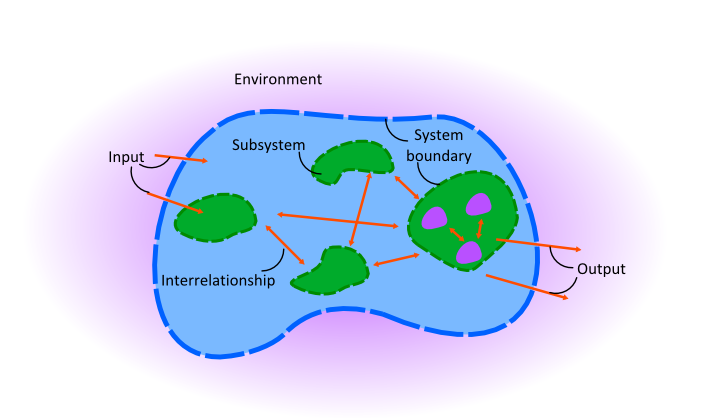Systems thinking
A system is often defined as a group of interacting, interrelated, or interdependent components that form a complex and unified whole. These components interact through processes, policies or information flows (Anderson and Johnson 1997). Different types of systems can be distinguished; ranging from cities to sports teams, from classrooms to ecosystems and from conceptual systems of understanding to systems of human activities. Although these systems differ in many ways, they have some basic characteristics in common:

- A system is an assembly of components connected together in an organized way;
- The components are affected by being in the system and are changed if they leave.
- The assembly of components does something;
- The assembly has been identified by someone as being of interest
(adapted from Postgraduate Diploma in Systems Thinking in Practice)
In literature (see soft systems methodology and Bosch et al. 2006, Capra, 1996) a distinction is made between hard and soft system thinking. Hard system thinkers’ attempt to represent reality in an objective way, whereas ‘soft system thinkers’ recognize that representations of reality are constructs made by the person describing them and are influenced by histories, world views, and values of that person.
A hard system representation of a Building with Nature project attempts to show causal relations between ecosystem processes, hydromorphology and human-induced processes, without considering differences in perspectives of actors involved in the project. A soft system approach starts with exploring perspectives of actors on the socio-ecological system of interest (see Ostrom, 2009).
Bosch et al. (2006) describe three functions of systems thinking. All three are potentially helpful in Building with Nature contexts.
- Getting the big picture. Understanding a complex system asks for expertise from different fields of knowledge. Communication in such multidisciplinary settings is often difficult. The construction of one system representation helps to cross discipline boundaries and to see the big picture.
- Aligning different perspectives. Building with Nature designs need to consider differences in perspectives of the actors involved. Translation of these perspectives into multi-functional designs is part of the Building with Nature practice. The use of system representations facilitates sharing and comparing differences in opinions, values, histories, interests, etc. in relation to the design.
- Learning. Representations of systems show the state of such systems under certain conditions. Facilitation of learning is possible by monitoring changes in reality and adapting the system representation to the monitoring results.
